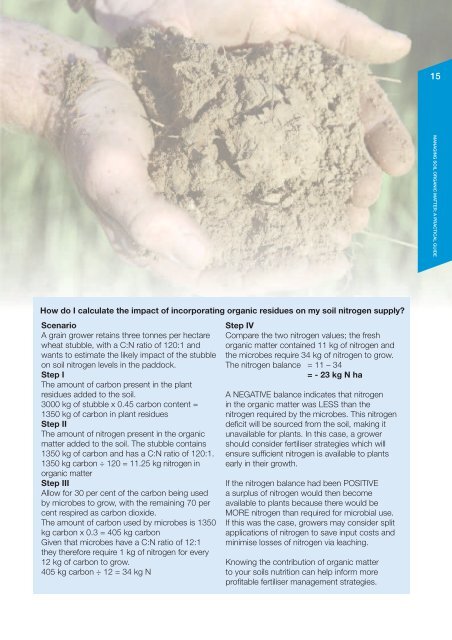managing soil organic matter - Grains Research & Development ...
managing soil organic matter - Grains Research & Development ...
managing soil organic matter - Grains Research & Development ...
Create successful ePaper yourself
Turn your PDF publications into a flip-book with our unique Google optimized e-Paper software.
15MANAGING SOIL ORGANIC MATTER: A PRACTICAL GUIDEHow do I calculate the impact of incorporating <strong>organic</strong> residues on my <strong>soil</strong> nitrogen supply?ScenarioA grain grower retains three tonnes per hectarewheat stubble, with a C:N ratio of 120:1 andwants to estimate the likely impact of the stubbleon <strong>soil</strong> nitrogen levels in the paddock.Step IThe amount of carbon present in the plantresidues added to the <strong>soil</strong>.3000 kg of stubble x 0.45 carbon content =1350 kg of carbon in plant residuesStep IIThe amount of nitrogen present in the <strong>organic</strong><strong>matter</strong> added to the <strong>soil</strong>. The stubble contains1350 kg of carbon and has a C:N ratio of 120:1.1350 kg carbon ÷ 120 = 11.25 kg nitrogen in<strong>organic</strong> <strong>matter</strong>Step IIIAllow for 30 per cent of the carbon being usedby microbes to grow, with the remaining 70 percent respired as carbon dioxide.The amount of carbon used by microbes is 1350kg carbon x 0.3 = 405 kg carbonGiven that microbes have a C:N ratio of 12:1they therefore require 1 kg of nitrogen for every12 kg of carbon to grow.405 kg carbon ÷ 12 = 34 kg NStep IVCompare the two nitrogen values; the fresh<strong>organic</strong> <strong>matter</strong> contained 11 kg of nitrogen andthe microbes require 34 kg of nitrogen to grow.The nitrogen balance = 11 – 34= - 23 kg N haA NEGATIVE balance indicates that nitrogenin the <strong>organic</strong> <strong>matter</strong> was LESS than thenitrogen required by the microbes. This nitrogendeficit will be sourced from the <strong>soil</strong>, making itunavailable for plants. In this case, a growershould consider fertiliser strategies which willensure sufficient nitrogen is available to plantsearly in their growth.If the nitrogen balance had been POSITIVEa surplus of nitrogen would then becomeavailable to plants because there would beMORE nitrogen than required for microbial use.If this was the case, growers may consider splitapplications of nitrogen to save input costs andminimise losses of nitrogen via leaching.Knowing the contribution of <strong>organic</strong> <strong>matter</strong>to your <strong>soil</strong>s nutrition can help inform moreprofitable fertiliser management strategies.
















